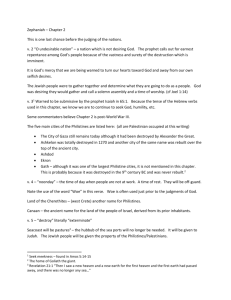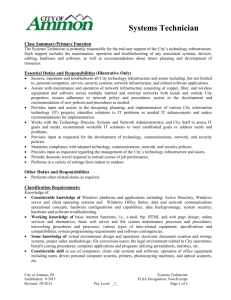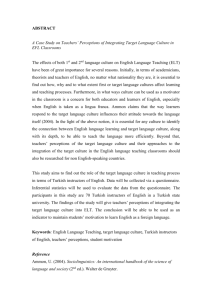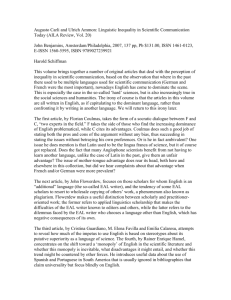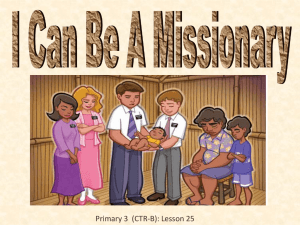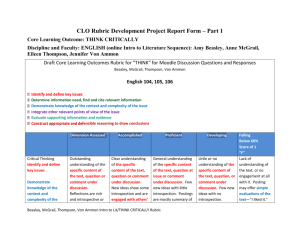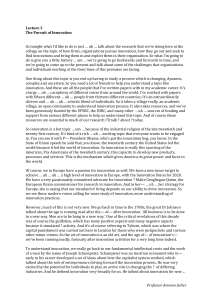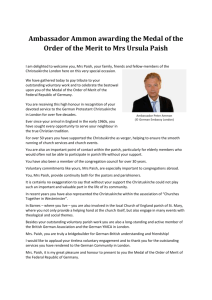Social Energy – A Revolutionary Concept of Therapy
advertisement
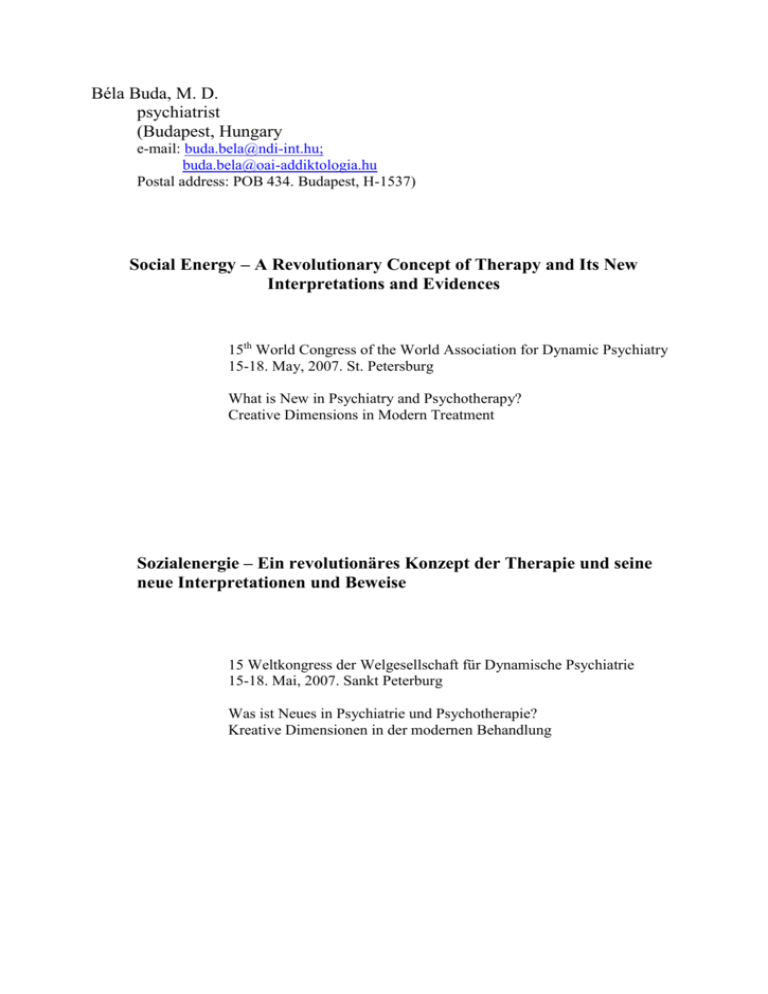
Béla Buda, M. D. psychiatrist (Budapest, Hungary e-mail: buda.bela@ndi-int.hu; buda.bela@oai-addiktologia.hu Postal address: POB 434. Budapest, H-1537) Social Energy – A Revolutionary Concept of Therapy and Its New Interpretations and Evidences 15th World Congress of the World Association for Dynamic Psychiatry 15-18. May, 2007. St. Petersburg What is New in Psychiatry and Psychotherapy? Creative Dimensions in Modern Treatment Sozialenergie – Ein revolutionäres Konzept der Therapie und seine neue Interpretationen und Beweise 15 Weltkongress der Welgesellschaft für Dynamische Psychiatrie 15-18. Mai, 2007. Sankt Peterburg Was ist Neues in Psychiatrie und Psychotherapie? Kreative Dimensionen in der modernen Behandlung Summary The paper outlines a view that the School of Dynamic Psychiatry of Günter Ammon rests on some conceptual cornerstones and one of them is the theory of social energy. It is a typical concept in this therapy system, since it is heuristic, innovative and integrating but at the same time casts in general terms and works with many implications and unexplained contents. A significant development of the school could be expected by expanding the ideas of social energy in a more detailed way. In order to initiate this process the paper looks back to the evolution of Freud’s theories of psychic energy, and the shift towards a social view of energetic and economic principle by Ammon, via the emergence of the ideas of narcissism, self and identity in the post-Freudian psychoanalysis. Ammon’s system is build upon group dynamics and group processes. Only group forces can foster arrested ego growth and identity development in severely impaired patients, because creation of healthy ego and identity structures need inputs of social energy. A quick overview is given of Ammon techniques and theories where social energy plays a crucial role, and recent articles coming from the Dynamic Psychiatric school to illustrate the depths of the daily therapy practices which are suitable for explanations in terms of the social energy principle. Keywords: psychic energy, social energy, Ammon’s theories, self, identity Günter Ammon created a new school of psychoanalysis and psychotherapy and left behind an impressive life work, not only in form of publications but also in a system of training, outpatient services and clinical practice. Looking at bulk of his books and articles and taking into account his long working activity his oeuvre seems to be full and completed. He enriched every part of his scientific field, he contributed to important theoretical issues as well as to therapeutic methodology. Nevertheless, this large intellectual heritage needs further scrutiny and reinterpretation, because it has many unexplored implications and condensed contents. Ammon was not a theorist. He was first of all therapist. His science he called “science of therapy” (Behandlungswissenschaft) and he valued concepts and theories as much as they were useful for the patients. Therefore he did not elaborated his theories in a classical scientific way, he did not strive for a complete overview of literature and for a thorough conceptual analysis, although his writings have many citations. He did not produce his publications for a scientific audience, but he wrote for therapists, his pupils in training, even for his patients who in process recovery had taken an active role in his clinic and in his milieu therapy projects or in some seminaries. This situation can be illustrated on the example of one of his pivotal theoretical concepts, social energy. This notion signifies a sort of epistemological turn in Ammon’s thinking. This is the cornerstone of his therapy system, but at the same time a symbol of his interpersonal, group dynamic orientation in the psychoanalytic theory. Both the therapy system and the reorientation in theory served the understanding and the treatment of the severely ill (called by him sufferers of archaic ego-disturbances) for him. Ammon went beyond neuroses and disorders of “discontents of civilisation” (to paraphrase Freud’s famous book title), the preferred territory of indications for classical psychoanalysis, and aimed psychotics, borderline patients, psychosomatic diseases, addictions. This is why he insisted to name his school as school of dynamic psychiatry. The dynamic moment is closely connected with the energy metaphor coined by Freud. As Rapaport called, the dynamic principle (Rapaport, 1960) was important for Freud to include quantity, strength in conceptualising drives and their conflicts, but also think about transformations of these drives, about the “fate” of them during the developmental process (quoting again a well-known Freudian publication title). The dynamic principle was important for Freud to speculate about psychic structures. Without presupposing structures continuity and order in behaviour and experience can not be explained. Structures were seen by Freud dynamic, i.e. using energies, like social structures need capital in order to function and to grow, and the main task of developmental psychology is to follow, how these structures develop, deteriorate or change. Dynamics and structure are basic concepts also for Ammon, but he shifted from an intrapersonal to a social focus. Social energy is highlighted in Ammon’s thinking to carry out this shift. Dynamics and structure are very important metaphors, their elaboration would need a monograph, but perhaps it is helpful if we take a short look at the evolution of the dynamic principle and the energy analogy in Freud’s theories. 1. History of the Idea of Psychic Energy in Psychoanalysis the energy metaphor at Freud in the beginning – tension release, sublimation, the economy model of instinctual forces later views of Freud – investments, the origin of ego’s energies, the concept of narcissism the theory of object relations – transference from the point of view psychic energy -- developmental aspects the issue of structure – the structural metaphor This table shows the evolving aspects of the use of the energy concept. Firstly Freud attributed different sources of drive energy for his supposed structural elements (ego, id) but later he thought always in terms of sexual energy, i.e. libido (leaving now his later attempt to introduce death instinct out of consideration). Libido is “invested” in psychic structures, relationship patterns function as structures, at least in terms of their libidinal content. “Investment” hints at an other side of the dynamic view, to the so-called “economy” (or economic) metaphor. The issue of narcissism was stressed by Freud later becoming crucial for ego psychology. At the late Freud and especially at his pupils like Hartmann, Federn, Fenichel and others structures was related mainly to the ego. Structures were meant as ways of perceiving, organising and using experiences in order to function in the world. 2. The Social Approach in the Analytical Understanding of the Energy Dimension the shift in focus of theory and of therapy towards the ego -- a hidden “cognitive turn” the emotional needs of child development – Spitz, the Harlow experiments – “the nature of love” Kohut and his emphasis on empathy and mirroring attachment theory and its consequences self theory and identity – creation and development of the person in relations and social processes This table is going over to the post-Freudian theory development in psychoanalysis. Even this process was led by challenges of therapy, since old models of tension release, insight, working through, etc. Did not explain and could not guide theory. Transference implied dynamic thinking and structures were imagined as stable mechanisms of knowledge about reality and of control over inner conflicts and wishes. Self was conceptualised as a historically evolved system of such structures. The words of this table are familiar from Ammon’s writings, he had closely followed this theoretical lines and thought us a lot about them, thus it is not necessary to quote the relevant literature here, the titles are regarded as classics in the school dynamic psychiatry, too. Kohut’s influence along these lines is still remarkable (Karterud, Monsen, 1999, 2005), he influenced also Ammon. Ammon grew out from these theoretical contexts. His contribution was a sort of synthesis. He integrated all these developments into his system (he rejected only the idea of a death instinct and did not accept the methodological conservatism and pessimism in the classical analysis) but expanded his horizons by working with therapy groups and taking group dynamics seriously. 3. Group Analysis – the Emergence of Group and Community Treatment shift from working through to social actions – living learning – insight and change through communicative behaviour and emotional experiences social reality in therapy – experiencing rules and boundaries – the therapeutic community Ammon – early innovations – new understanding of group dynamics, large group, milieu therapy The therapeutic challenge of the borderline syndrome and psychosis to Ammon’s theoretical work – the problem of the essence of therapy This table shows the appearance of the group dynamic approach in general and at Ammon. Again we know well, how much he was open to extend also the group concept, for example he resonated early to the large group technique which included organisational reality into therapeutic world, or he saw family as a centre for primary group, and thereby he introduced group dynamics also into family socialisation process in order to understand the genesis of archaic ego disturbances (Ammon, 1973, 1980, Ammon, 1979a). Ammon also investigated basic human capacities, such as aggression or creativity from a group dynamic point of view (Ammon, 1970, 1974). Historically Ammon was motivated to theoretical innovations as well as to deploy new treatment methods by the challenges of the borderline syndrome, which he had encountered in increasing amount in his and his pupils’ practice (Ammon, 1988a). The problems of narcissism and identity were consequently followed by him along his effort to deal with impaired personality structures, as it can be seen from his yearly lectures at the DAP and WADP congresses (Ammon, 1988b). 4. Social Energy – the Evolution of a Concept the emergence of social factors in Ammon’s theories – the Laios complex, the role of primary group in child development, the psychoanalytic kindergarten, living communities, social participation of patients, chains of (group) therapy modalities the role of interactions and group relations – an implicit use of social energy view formulation of social energy as a core concept – a late theoretical synthesis and elaboration for explaining therapy processes and effects, with special regard to archaic ego disorders the growing role of identity in the expanding holistic and multidimensional horizon of Dynamic Psychiatry The sentences mentioned in this table hint at Ammon’s theoretical and methodological innovations and sources of experiences which had influenced and stimulated him later to turn towards social interaction. The idea of social energy was born as well as a new approach to therapeutic structure development and correction, which was called the socioenergetic principle or principle of social energy (Griepenstroh, von Wallenberg Pachaly, in: Ammon, 1979b), which is similar to Freud’s psychic energy, but is essentially different from it, since energy is conceived not being inherent in the person, but coming from outside, from the significant and meaningful interaction partners. The idea of social energy acted as a revelation for all those who were followers of Ammon, because its synthetic force struck everybody immediately and its many implications became clear. Social inputs were conceived as narcissistic nurturance, but mainly as activating identity processes. Identity work is going on in exchange influences in groups and in social transactions. 5. Excerpt from Definitions of Ammon Concerning Identity “Identity as a dynamic process evolving on the border between the individual and the group, identity as interpersonal space, and identity as provoking change in other persons. The dimensions of identity as an economic principle, i.e. psychic energy as social energy and thus the dynamic nucleus of egostructural development.” (Ammon: Identität – ein Geschehen an der Grenze von Raum und Zeit. Zum Prinzip Sozialenergie. [Vortrag, 1981. XIII. Internat. Symp. der DAP, München] in Günter Ammon: Vorträge 1969-1988. 1988.Pinel Verlag, München, p. 276.) This is expressed in short definitions given by Ammon. 6. Ammon about Social Energy “Social Energy is energy which causes the ego-structure to grow. This ego-structure is be understood as social energy which manifested itself as the result of group-dynamic contacts, processes and conflicts. The essential feature of these groupdynamical relations is taking the other person seriously, both in terms of approval and criticism. Social energy is the motivational factor of the developmental process of any individual. Identity is the sum-total of the social energy which one has received up to now, both in a quantitative and in a qualitative respect. Social energy fulfils a transmitting function between the here and now of group processes and the effects on the ego structure of a given person.” (Ammon: Identität – ein Geschehen an der Grenze von Raum und Zeit. Zum Prinzip Sozialenergie. [Vortrag, 1981. XIII. Internat. Symp. der DAP, München] in Günter Ammon: Vorträge 1969-1988. 1988. Pinel Verlag, München, pp. 276-7.) A more detailed definition deals again with identity, i.e. social energy is viewed in the framework of identity. 7. Ammon – Social Energy versus Psychopathology “The concept of a social-energetic circle also helps to understand the vicious circle of pathological development, the inevitability for psychically ill people to have destructive and deficitary group experiences, and it helps to realise the starting-point of social energetically constructive group-dynamics as a therapeutic means. In therapy, existential border situations are essential for the patient, for such situations his identity can grow. The identity of a person is shaped by every meaningful contact; therefore identity is to be conceived of as the ever-changing, holistic result of a chain of meaningful contacts border situations.” (Ammon: Identität – ein Geschehen an der Grenze von Raum und Zeit. Zum Prinzip Sozialenergie. [Vortrag, 1981. XIII. Internat. Symp. der DAP, München] in Günter Ammon: Vorträge 1969-1988. 1988. Pinel Verlag, München, p. 277.) This is the most important element in the social energy concept, because in therapy not the disease, the psychopathology has to be evaluated, but the restitutive, reconstructive processes have to be supported and this can be realised along social energy dimensions. 8. Ammon – Further Important Thoughts “A lack of social energy arises when all attention, interest and meaningful contact is denied whether consciously or unconsciously. Bodily contact is also of extreme importance of social energy. People who have never been caressed and have never experienced bodily contact have not received social energy in a large sector of themselves which reaches deep within their personality. The deficient dynamics of social energy are expressed in a lack of interest and a lack of attention in the case of formal supervision.” (Ammon: Identität – ein Geschehen an der Grenze von Raum und Zeit. Zum Prinzip Sozialenergie. [Vortrag, 1981. XIII. Internat. Symp. der DAP, München] in Günter Ammon: Vorträge 1969-1988. 1988. Pinel Verlag, München, p. 293.) These excerpts point out to the nature of social energy in human contacts, but these thoughts lead to the so-called human-structural development of Ammon’s view of man, of his psychological anthropology (in the sense of Gadamer, who postulated an anthropology in every ontological field of human sciences). As we know, he integrated biological processes and dimensions of spirituality into his later theoretical system. 9. The Social Energy Concept -- Condensed and Almost Cryptic the historical context in Ammon’s movement in Germany and world-wide – therapy systems and new therapy approaches and modalities, researches, and the ”bodily dimensions” (neurophysiology) and spirituality, unconscious and its resources for creativity taking persons seriously, approval and criticism, the social energetic circle, bodily experiences, spirituality through exercising creativity – the ego-structural dance therapy the pivotal role of social energy concept in Dynamic Psychiatry – the central metaphor and Ammon’s heritage This is a continuation of Ammon’s thesis in the previous table, and it is written to illustrate, how high degree of abstraction is involved even in the explanations of the social energy principle, and how large realms of experiences and contexts are implied by them. Before going further to inquire into social energy concept can function as a bridge to other schools of therapy, where similar processes are described and emphasised. Without a claim to a full overview, in the next table kin concept of central importance are shown in other schools and theories of psychotherapy. Grawe merits mentioning because most of the alternative views which he enlists as acting forces in psychotherapy and which are often meant as criticism against dynamic vies, can be translated to terms of the social energy principle (Grawe, Donati, Bernauer, 1995, Grawe, 1998). This translation could be a conceptual research in order to reach a more deep understanding of Ammon. Again, evaluation of the vast literature about self-help groups (Höflich, Meyer, Matzat, Beutel, 2007. – in order to quote only a recent publication from the rich German language output), or about the systemic community treatment approach (e.g. Mosher, Burti, 1994) would produce many examples and co-roborations for a social energy interpretation of results and data stemming from these fields. Identity enhancement (a term coined after experts of philosophy of medicine trying to explain different processes of human capacity development -- e.g. Parens, 1998) is widely accepted in modern society in a variety of group practices, e.g. in awareness raising, encounter, training, communication, role enrichment, etc. Groups, also demonstrate how effective and important social energy exchanges are, if they are incorporated to professional frameworks. They are, however, specific components in Ammon’s social energy concept, which can be supported by other schools’ experiences and theories or observations gained from different human social activities but which can not be reduced to them. These are the directions where further theory building and conceptual work would be needed within the school of Dynamic Psychiatry. Some of these elements are listed in the next table. 11. Specific Elements in the Therapy System of Dynamic Psychiatry Related to Social Energy the dialectics of taking a patient seriously – concern, support, tolerance, meaningful tasks, challenges and empowering human destruction – a neglected or repressed area in other systems of psychotherapy, the issue of constructive aggression artistic – i.e. symbolic, metaphorical, archetypical – communication through creative group therapies the bodily dimension and the ego-structural dance therapy peak experiences in real life processes, rites, fests, commemorations world view issue—multidimensional participation at humanistic values This is what is familiar for all of us from the daily practice of dynamical psychiatry. Each of one, however, could be grasped by new definitions, could yield phenomena to qualitative and quantitative inquiry. You associate, surely, to these sentences the milieu therapy which is a wonderful innovation of Ammon, the human structural dance therapy, which is a joint product and true discovery of the core teams of the school and which is quite unique still world-wide, even though body therapies are mushrooming, or the use of artistic self-expression and identity work in creative therapies deployed in the different treatment modalities of Dynamic Psychiatry. Human destruction remains a No.1. enemy in out approach, but we need further research to tame it or to convert it to constructive forms of self-assertion and communication. There are crucial events of manifestation of social energy, such are the peak experiences (a term borrowed from Maslow, and closely connected with this issue, spirituality and world view taken in the sense of existential philosophy and psychotherapy) can be investigated also from the point of view of social energy or could be compared with Ammon’s handling these questions in his writings. Just to demonstrate that Dynamic Psychiatry is living and practising social energy principles attention should be directed towards a recent thematic number of the journal Dynamische Psychiatrie (Dynamic Psychiatry) 2006. Jg. 39. 2. No. 217, dealing with therapeutic communities. We have to remember, that according to Ammon there are destructive social energies and destructive structures can be developed in the self in consequence of them, thus social energy can not only deficitary, i.e. insufficient, but also it can manifest itself in pathological forms. In two interesting papers the life of living communities for chronic patients is portrayed (Reitz, Hessel, 2006, Splete, 2006). Both articles show the professional organisation of the communities aims to foster the development of identity. For this they fulfil multiple tasks. There is a balance between conflicting forces. The group environment can be supportive but also therapeutically counterproductive. Psychopathology – e.g. pathologic repetition compulsion, fixations in structure development, destructive aggression, anxiety, especially the fear of contact etc. have to be counteracted, sometimes by therapeutic splitting, where at other, different, more strongly integrated group sitting has to be used to work through phenomena of negative transference and destructive strivings. Groups can cause traumas, e.g. through scapegoating some members, or allowing to some persons to fill in an oppositional leader role in the group. Therapeutic team has to be supported by counselling and supervision (control) groups. Project groups and milieu therapy are helpful, they yield realistic self esteem and offer fields for learning and acting. Levels of reality and relationships have to be dealt with separately. Conflicts have to be manifested. Transference might be destructive but if manifested in a controlled way they can enhance social energy processes. Groups have to provide corrective experiences. In general, groups – even in living communities – have to be environments which create identities by their stimulating effects. The boundaries of groups play an important role in securing spaces for protection and for growth of identity. Group leadership is emphasised as the source of therapeutic effects. As Ammon stated: “The central position of the leader attracts the destructive potential of blocked conflicts in process of group dynamics and thereby sets free basic energies to create an interpersonal field for identity awareness in the groups” (Ammon, 1976, p. 55.). In well functioning groups auxiliary ego functions are also manifested where group members help each other in interactions. These are only selected concepts which are used for initiating and regulating as well as for evaluating group dynamic processes in living communities. Thus communities became important parts in a chain of therapeutic modalities in which interventions are co-ordinated. This is illustrated in the papers by case studies. The realistic episodes and problems described here show the manifestations of social energy but also the implications and uncertainties of the concept. The metaphor should be converted to psychological and interpersonal concepts which can be used for indications, process monitoring and evaluation. To put in other terms, the magnificent theory system of Ammon – as outlined in the two volumes of Handbook of Dynamic Psychiatry, edited by Ammon (Ammon, 1979b, 1982, 2000) – and especially his social energy theory have to be developed by re-formulations, re-interpretations and comparisons with similar key concepts in other schools in order to continue the evolution of Dynamic Psychiatry. Literature Ammon, G. (1970): Gruppendynamik der Agression. Kindler, München. Ammon, G. (1973): Dynamische Psychiatrie. Grundlagen und Probleme einer Reform der Psychatrie. Luchterhand, Darmstadt. Ammon, G. (Hrsg.) (1974): Gruppendynamik der Kreativität. Kindler, München. Ammon, G. (Hrsg.) (1976): Analytische Gruppendynamik. Hoffmann und Campe, Hamburg Ammon, G. (1979a): Kindesmisshandlung. Kindler, München. Ammon, G. (1979b): Handbuch der Dynamischen Psychiatrie. Bd.1. Ernst Reinhardt Verlag, München. Ammon, G. (1980): Dynamische Psychiatrie. Kindler, München. (erweiterte Neueauflage) Ammon, G. (Hrsg.) (1982): Handbuch der Dynamischen Psychiatrie. Bd.2. Ernst Reinhardt Verlag, München. Ammon, G. (1988a): Das Borderline-Syndrom. Krankheit unserer Zeit. “Pinel” Verlag für humanistische Psychiatrie und Philosophie, Berlin. Ammon, G. (1988b): Vorträge 1969-1988. “Pinel” Verlag für humanistische Psychiatrie und Philosophie, München. Grawe, K. (1998): Psychologische Therapie. Hogrefe, Verlag für Psychologie, Göttingen, Bern, Toronto, Seattle. Grawe, K.; Donati, R.; Bernauer, F. (1995): Psychotherapie im Wandel. Von der Konfession zur Profession. Hogrefe, Verlag für Psychologie, Göttingen, Bern, Toronto, Seattle. (4. Auflage) Griepenstroh, D.; von Wallenberg Pachaly, A. (1979): Das energetische Prinzip bei Freud und Ammon. In: Ammon, 1979b, pp. 213-232. Höflich, A.;Meyer, F.; Matzat, J.; Beutel, M. E. (Hg.) (2007): Selbsthilfegruppen für psychisch und psychosomatisch Kranke. Zuganswege – Barrieren – Nutzen. Bundesverband der Betriebskrankenkassen, Essen. Karterud, S.; Monsen, J. T. (1997): Selvpsykologi. Utviklingen etter Kohut. Ad Notam Gyldendal, Oslo. Karterud, S.; Monsen, J. T. (2005): Szelfpszichológia – a Kohut utáni fejlődés. (Hungarian translation; Self Psychology -- the Development after Kohut)Animula, Budapest. Mosher, L.; Burti, L. (1994): Community Mental Health. A Practical Guide. W. W. Norton & Co. New York, London. Parens, E. (ed.) (1998): Enhancing Human Traits. Ethical and Social Implications. Georgtown University Press, Washington D. C. Rapaport, D. (1960):The Structure of Psychoanalytic Theory. A Systematising Attempt. International Universities Press, New York. Reitz, G.; Hessel, T. (2006): Erfahrungenund Ergebnisse aus der Arbeit in den Wohngemeinschaften der Dynamischen Psychiatrie. Dynamische Psychiatrie/Dynamic Psychiatry. 39. Jg. 2. No. 217. pp. 126-141. Splete, R. (2006): Zur Gruppendynamik der Aufbauphase therapeutischer Wohngemeinschaften (TWGs). Dynamische Psychiatrie/Dynamic Psychiatry. 39. Jg. 2. No. 217. pp. 175-190.
